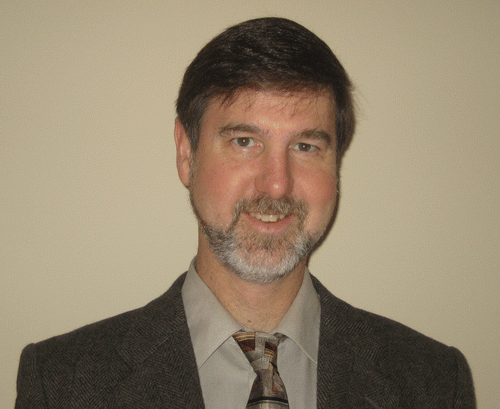The 2007 recipient of the J. Eugene Robinson Award is Professor Paul R. Stauffer. Each year the Society of Thermal Medicine (STM), previously known as the North American Hyperthermia Society (NAHS), presents this award to an individual that has provided outstanding contributions to the scientific foundations of hyperthermia therapy as well as demonstrated significant devotion to the society. This award is given in memory of Dr J. Eugene Robinson (1925–1983), who not only was a pioneer in hyperthermia research in the 1970s, but is also remembered for his high level of ethics and integrity, energy, enthusiasm, innovation, and non-assuming demeanour. Based upon the merit of his contributions to the field of hyperthermia and personal attributes, Professor Stauffer was rightly selected as the 18th recipient of this award.
Paul received his BA in Physics from the College of Wooster, Ohio, in 1975. He relocated in 1976 to Tucson to attend graduate school at the University of Arizona, where he subsequently received his Masters Degree in Electrical Engineering in 1979. He remained at the University of Arizona Health Sciences Center for the next few years as a Staff Research Associate within the Radiation Oncology Department, which at that time had one of the largest academic hyperthermia programmes in the country and was noted for the development and translation of interstitial, superficial and deep heating techniques from the research setting into clinical practice. Paul moved to Northern California in 1983 to hold the position of Assistant Professor and Director of Hyperthermia Physics at the Radiation Oncology Department at the University of California, San Francisco (UCSF). During the next 23 years, Paul developed and maintained a productive research and clinical hyperthermia programme. In 2006, as a Professor at UCSF, Paul decided to join the Duke University Hyperthermia Program where he is currently a Professor and Director of Hyperthermia Physics, and continues to make valuable contributions to the field.
From the early days at the University of Arizona, through the many years spent at UCSF and more recently at Duke, Paul has made numerous and significant scientific contributions to the field of hyperthermia cancer therapy. Examples that demonstrate the breadth of these contributions would include the following: the development of ferromagnetic seeds and induction coil designs for applying interstitial hyperthermia; the design of microwave phased arrays for neck applications; working with task groups and developing clinical and physics QA guidelines; design of microwave eye plaques for treating choroidal melanoma; development of interstitial helical microwave antennas; evaluation of the HELIOS, a 32 transducer focused ultrasound hyperthermia system; co-PI on a number of clinical studies at UCSF investigating superficial heating technology, interstitial heating, and combining hyperthermia with Doxil for treating recurrent chest wall disease; and more recently the development and implementation of conformal microwave arrays and vests for treating large area superficial disease, with integrated microwave radiometry for non-invasive treatment monitoring and compatibility with concurrent radiation therapy. Furthermore, Paul should be noted as an inventor of a class of helical coil microwave antennas that were subsequently used in clinical studies at UCSF to establish a survival benefit of hyperthermia in a prospective randomized trial of brachytherapy boost +/− hyperthermia for glioblastoma multiforme. This clinical study, reported in 1998 by Dr Penny Sneed et al., represents the first positive phase III randomized trial performed in North America which indicated the benefits of hyperthermia. Additionally, Paul is also known for suggesting to Dr Bill Dewey the acronym CEM43T90, which was introduced in 1994. Paul continues to make significant strides in engineering development and clinical studies with many ongoing investigations at Duke University.
Professor Paul Stauffer has devoted much effort and time over the years to our society through active participation on committees and serving on the governing council. Since 1987, Paul has served 12 years as an elected member of the governing council for NAHS and STM: two terms as Physics Councillor (4 years), multiple terms as Secretary-Treasurer (∼6 years), recently elected Vice President Elect in 2005 (a 4-year term) and is currently serving in the capacity of President. In addition to serving on council, Paul has been a participating member in more than 21 NAHS/STM committees (e.g. programme committees for national and international meetings, professional affairs, constitution and bylaws, finance committee, QA, commercial relations, NAHS vision, mission & name, reimbursement reform, etc.), with his total committee service time to date adding up to more than 42 ‘Committee’ years.
The Society of Thermal Medicine is grateful to Professor Stauffer for his dedication to hyperthermia research and service to our society, and we are confident that he will continue to impact the field of hyperthermia cancer therapy positively. We also extend our appreciation to Debby, his wife since the early Tucson days, and his children, Ryan, Alison, and Jessica, for their extraordinary support of Paul over the years.
Chris J. Diederich, PhD
Thermal Therapy Research Group
Radiation Oncology Department
University of California, San Francisco
Box 1708, San Francisco, CA 94143
Tel: 415-353-9928. Fax: 415-353-9883
Email: [email protected]
